Both the D10 Plus and Q7 Max are budget-friendly but feature-rich robots. And without further ado, the D10 Plus is the overall winner.
They can draw maps very accurately thanks to LiDAR technology and save multiple maps for multi-story apartments. They have a 5,200mAh battery that gives them an incredibly long battery life, and the recharge and resume feature reduces your involvement in the charging process. They will also give you countless smart features once they are connected to the respective app.
Apart from the features shared above, the Dreame D10 Plus comes with a self-cleaning base and is one of the cheapest robots with this nifty unit. It also brings mopping to the table, which, in my opinion, delivered a decent performance. Considering it’s the same price as the Roborock Q7 Max, it’s really a steal!
Dreame D10 Plus Vs Roborock Q7 Max: Comparison Chart




Dreame D10 Plus Vs Roborock Q7 Max: Differences
The D10 Plus wins 4-3 against the Q7 Max, and that is just the tip of the iceberg. Let’s embark on my detailed exploration of comparing these two workhorses!
Cleaning Performance
Winner: Dreame D10 Plus
Airflow
| Dreame D10 Plus | Roborock Q7 Max | |
|---|---|---|
| Quiet | ≈ 9,6 CFM | ≈ 7.6 CFM |
| Standard/Balanced | ≈ 10,3 CFM | ≈ 9.6 CFM |
| Strong/Turbo | ≈ 12,1 CFM | ≈ 10.1 CFM |
| Turbo/Max | ≈ 17,3 CFM | ≈ 15.8 CFM |
Despite its more budget-friendly price tag, the D10 Plus consistently surpasses the Q7 Max across all four power settings. Both robots boast airflow levels that are notably higher than many budget-category robots, especially at their peak settings, which directly led to their excellent scores on my hardwood floor.
| Dreame D10 Plus | Roborock Q7 Max |
|---|---|
| ≈ 99% | ≈ 97% |
Their performances on my hardwood floor were overall excellent, with almost all debris picked up easily. The D10 Plus proves itself to be a superior choice for cleaning this type of surface, but the Q7 Max was also great.
Carpet
| Dreame D10 Plus | Roborock Q7 Max | |
|---|---|---|
| Low-pile Carpet | ≈ 97% | ≈ 94% |
| High-pile Carpet | ≈ 98% | ≈ 95% |
I also conducted cleaning experiments on low- and high-pile carpets with these two bots. And once again, the results were impressive for budget-level robot vacuums, and the D10 Plus took the lead as well.
Hair Pet
| Dreame D10 Plus | Roborock Q7 Max | |
|---|---|---|
| 5-inch Strands | ≈ 61% | ≈ 87% |
| 10-inch Strands | ≈ 47% | ≈ 61% |
I also tested them on five and ten-inch strands to see how well they could remove hair and resist tangles. While the Q7 Max was decent in both tests, the D10 Plus didn’t do the job well. So I don’t recommend the D10 for cleaning pet hair, especially long hair.
There was a fair amount of hair getting tangled around their brushrolls, and untangling the one on the Q7 Max was a breeze thanks to its bristle-zero design. As for the D10 Plus’s combo roller, you will need something, such as an included cleaning tool or a scissor, to get the job done.
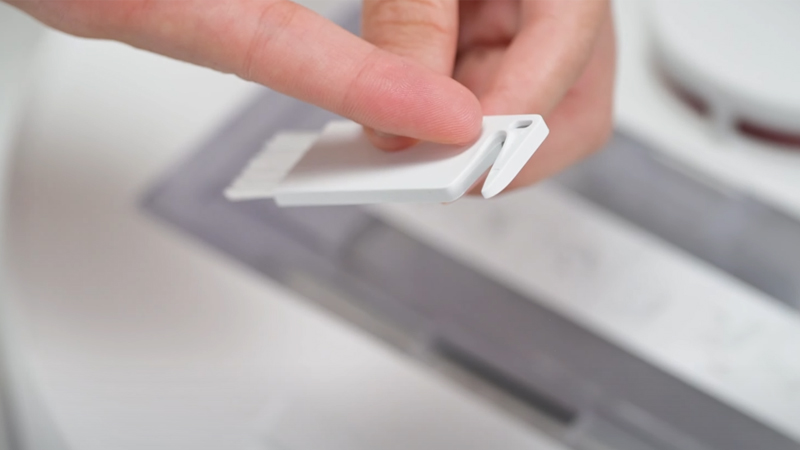
Design & Usability
Winner: Roborock Q7 Max
Dimensions & Weight
| Dreame D10 Plus | Roborock Q7 Max | |
|---|---|---|
| Dimensions (W x H) | 13.7 x 3.8 inches | 13.8 x 3.8 inches |
| Weight | 7.9 lbs | 8.38 lbs |
Most robot vacuums use a pucked-shaped frame, which is true for the D10 Plus and Q7 Max. In terms of dimensions, they are quite comparable and taller than robots that rely on integrated cameras for navigation due to a little tower on top that houses “LiDAR.” But they’re still adept at maneuvering beneath the majority of furniture pieces with ease.
By the way, while the Q7 Max comes with a compact charging dock, the D10 Plus comes out of the box with a dust collection base that could be more problematic size-wise. But, honestly, I suspect that the appeal of this self-cleaning base’s convenience would overshadow any concerns about its bulky footprint.
Extractor & Side Brush

Shifting your attention to the underside, you will see the D10 Plus features an old-fashioned combo brush while the Q7 Max boasts a rubberized roller devoid of bristles. The D10 Plus’s brush is undoubtedly more susceptible to tangling than the one on the Q7 Max. But, on the bright side, the included cleaning tool ensures those tangles are easier to deal with.
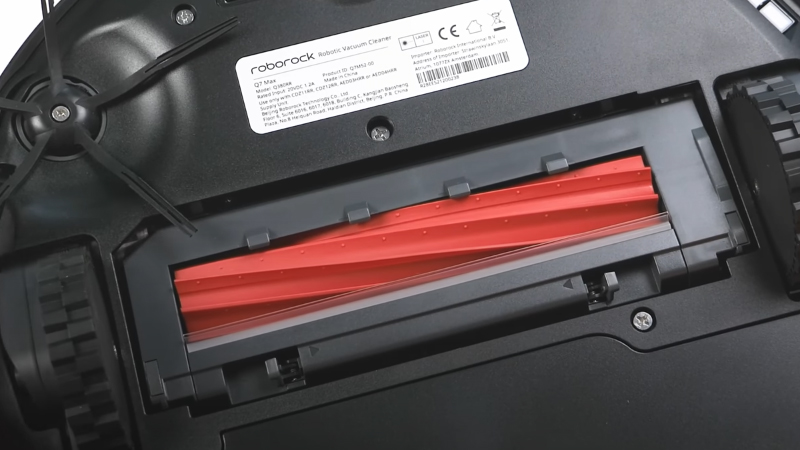
Each machine is fitted with a corner brush that operates on a single side instead of two, yet this setup doesn’t greatly impact their cleaning performance. There’s a distinction: the D10 Plus features a 3-pronged brush with bristled tips, whereas the Q7 Max boasts a 5-pronged rubber brush, which has an advantage in durability.

Navigation
The D10 Plus and Q7 Max rely on LiDAR (or Laser Distance Sensor) as their primary tool for mapping and navigation. This navigation technology makes them slightly higher than vSLAM-based robots, which use a built-in camera instead, but their speed and precision are no joke. They can complete a map of your living area within just a couple of runs, and as a bonus, they can function efficiently even in dimly lit areas.
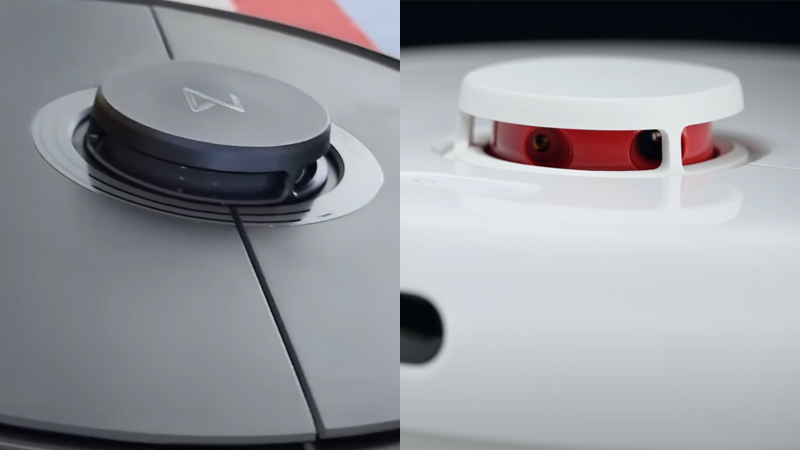
In addition to drawing maps quickly and accurately, these bots can save multiple layouts, so they can clean multiple floors without having to continuously re-create maps. The D10 Plus can save 3 map levels, whereas the Q7 Max can save 4. Then, you can edit these maps via the respective app, which I’ll expand upon later.
Since both use a laser sensor for navigation during cleaning, they will clean the edges first before vacuuming the middle portions in straight lines until the entire floor is covered.
They have no specialized sensors for obstacle-evading capability. But the front-facing sensor causes the robots to slow their pace when nearing obstacles, gently touching them, while the built-in bumper ensures no one gets hurt. Still, it’s a smart move to pre-clean your living area, especially if you are a pet owner, to make their job easier.
Battery Life
| Dreame D10 Plus | Roborock Q7 Max | |
|---|---|---|
| Battery Life | ≈ 82-197mins | ≈ 91-183 mins |
| Charging Time | ≈ 181 mins | ≈ 198 mins |
These little housekeepers share an internal 5,200mAh lithium battery, allowing them to run continuously for up to 3 hours as long as they are in the lowest power setting. Of course, the actual runtime will be shorter if the vacuum is used on higher power settings. And given that both have a “Recharge and Resume” function, you don’t need to recharge them manually. I mean, they can return to their docking station when their battery is low, recharge themselves, and then continue cleaning from where they left off.
Control
Winner: Tie
Manual Control
Both have buttons on their control panels for physical controls. The D10 Plus features two buttons: one for initiating a cleaning cycle and another to guide it back to its dock, either for recharging or bin emptying. The Q7 Max also has two such buttons and an additional “Spot Cleaning” button, which, as its name suggests, commands the robot to focus its cleaning on a specific, localized area where it’s placed. That way, you can have the Q7 Max programmed to clean up a mess in the kitchen, for example.
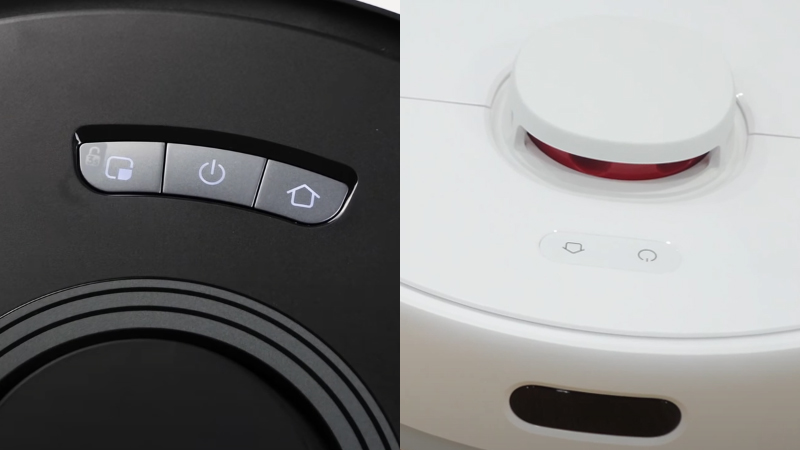
App Connectivity
The D10 Plus and Roborock Q7 Max are compatible with the Xiaomi Home and Roborock Home apps, respectively. They share a lot of high-end features and functions, which I’ll mention below.
These apps have a “Live Map” option, giving you a bird’s-eye view of the robot’s location in real-time with lines that reveal all the zones have been cleaned. The Roborock app can also show the map created in 3D form, with the option to add furniture – That sounds great and modern, but I’m still pondering how it holds any edge over the straightforwardness of 2D maps.

The D10 Plus and Roborock Q7 have the capability to be voice-commanded through platforms like Google Home and Amazon Alexa, allowing users to initiate, halt, or pause cleaning sessions for a more hands-free cleaning experience. But there are no ins and outs on how to do that from the app, and you will need to figure it out yourself. You can also set an automated schedule in the app so that your bot operates automatically every day.
Speaking of editing maps, both apps enable you to section and name the rooms to specify single-room cleaning. Then, you can set no-go zones and no-mop zones using square blocks to keep robots away from spaces like pet resting areas or children’s play zones laden with Lego blocks. You can use invisible walls to block diagonal areas, which is impossible with no-go zones. The Xiaomi Home also has the option to set clean areas to clean up specific zones within a room.
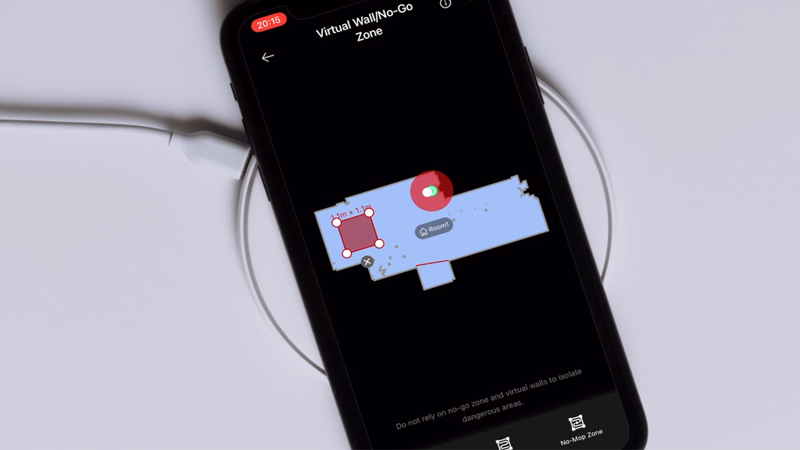
Both apps keep you informed about the health of critical components, such as the filter, main brush, and side brush, highlighting when a change is needed. And to maximize the longevity of these parts, consistent cleaning and upkeep are essential.
Cleaning & Maintenance
Winner: Dreame D10 Plus
The D10 Plus features a good-sized 0.4-liter dust box on board compared to a 0.47-liter on the Q7 Max. Each comes with a washable filter, and the D10 Plus even comes with a spare filter, so it can do the job with one while giving the other time to dry after washing.

The D10 Plus comes with a multifunctional base station that not only automatically recharges the battery but also empties the dustbin, so doing this menial task manually is no longer needed. The Q7 Max doesn’t come with such a self-cleaning station, but the Q7 Max Plus does.
The base of the D10 Plus houses a dust bag with a 2.5-liter capacity, which is quoted as lasting around 45 days, but it will depend on a few factors like usage and environment, among others. During my testing, the Dreame D10 Plus could not always successfully return to its home base. It jammed itself in places it couldn’t escape several times, so, once again, pre-cleaning up your floor is essential.
Other Features
Winner: Tie
Noise
| Dreame D10 Plus | Roborock Q7 Max | |
|---|---|---|
| Working | ≈ 48-59 dB | ≈ 49-62 dB |
| Self-Emptying | ≈ 63 dB | None |
Both the D10 Plus and the Q7 Max were quiet in the three lower settings, so you can hardly notice them in operation. Still, their noise levels increased significantly in the max setting when crossing onto the carpet. The D10 Plus also becomes especially noisy when docking at its base for bin-emptying, which is a short but noticeable stage.
Mopping Ability
Both the D10 Plus and Q7 Max can mop the floor, which has become common in this era, given the rise of hybrid robot vacuums. However, the real question at hand is: how effective are they in executing this task? Well, they’re good, but not really great for deep cleaning.
First off, both don’t have an active agitation system, so they aren’t definitely comparable to other bots with an agitation element like the Roborock S7 MaxV. They worked well with red wine stains but struggled during the dried BBQ sauce stain test, a common hurdle for robots lacking an agitation component. Additionally, if you’re thinking of using these bots to mop up juice or food-related spills, just don’t. They tend to leave behind sticky residue, given that they simply drag a wet pad across the spill.
What’s more, these 2-in-1 robots have no mop-lifting system, so you will need to set no-mop zones and manually remove the mop pad before cleaning your carpets for more peace of mind.

Quick Rundown Of Dreame D10 Plus
- 45 Days of Hands-Free Cleaning: Fully automate your day-to-day cleaning to live more comfortably. An auto-empty base station quickly and quietly dumps dirt and dust into a 2.5 L dust bag, while preventing clogging, to provide weeks of independent automated cleaning. All you have to do is dump the bag.
- Cleans Strong, Cleans Long: A max suction pressure of 4000 Pa easily lifts dirt from floors and deposits it into the 400 mL dust box. 4 suction modes to choose provide efficient, adaptable cleaning while a large, 5,200 mAh, battery delivers up to 180 mins of continuous cleaning to cover even large homes in a single run.
- High-Performance LiDAR Navigation: LiDAR laser navigation facilitates detailed rapid map building and remarkable navigation. Fast, accurate map building and systematic path planning help ensure spots aren't missed and cleaning isn't repeated.
- Effective and Adjustable Mopping: Set your water usage to wash your floors exactly the way you want. A 150 mL water tank and three water volume options let you adjust water usage and mop dampness according to how dirty the floor is for robust, efficient cleaning.
- Cleans at your Command: Compatible with Alexa voice control to put automatic cleaning at the tip of your tongue. Just say the word to start, pause, or stop your robot vacuum and make automatic cleaning even more hands-off.
Quick Rundown Of Roborock Q7 Max
- Deeper Cleaning with Powerful 4,200 Pa Suction: With 4,200 Pa maximum suction, the Q7 Max effortlessly lifts debris and pet hair from floors, drags dirt from cracks, and deep-cleans carpets; it automatically boosts suction when carpets are detected, ensuring thorough cleaning
- Vacuum and Mop Simultaneously: To eliminate fine dust that vacuuming alone might miss, this robot vacuum can vacuum and mop in one go; its electronic pump offers 30 adjustable water flow levels, allowing you to customize cleaning based on floor type and preference
- Clean Smarter with PreciSense LiDAR Navigation: Highly accurate LiDAR technology builds precise 3D maps of your home and identifies the most efficient cleaning routes; virtually recreate your space by adding furnishings and flooring materials for a more tailored cleaning experience
- Combined Dustbin & Water Tank: The 470 ml dustbin and 350 ml water tank combination supports longer cleaning sessions without the need for frequent emptying or refilling
- Effortless Cleaning with All-Rubber Brush: The all-rubber brush is specifically designed to resist tangles from long hair and pet hair; its multi-directional floating design maintains close contact with the floor, ensuring deeper and more efficient cleaning
Product Videos
Related Articles to Roborock Q7 Max
- Roborock Q5+ Vs Q7 Max: Which Roborock Robot Should You Choose?
- An In-Depth Review Of The Roborock Q7 Max Vs Dreame L10 Pro: Which is Better?
- Roborock Q7 Max Vs S7: What Are the Differences Between Them?
- Roborock Q5 Vs Q7 Max: An In-Depth Analysis
- Roborock Q7 Max Vs Xiaomi S10T: A Detailed Comparison
- Roborock Q7 Max Vs Eufy X8: What Is The Best Option For Your Home?
- Viomi S9 Vs Roborock Q7 Max: Battle of the Feature-Rich Bots
- Viomi V5 Pro Vs Roborock Q7 Max: Which One Gets My Winning Ticket?
- Roborock Q7 Max Vs Dreame Z10 Pro: A Detailed Face-Off Comparison
- Roborock Q Revo Vs Q7 Max: Duel of the Roborock Dust-Suckers
- Roborock Q7 Max Vs Q7: What Does The “Max” Label Refer To?
- Dreame D9 Max Vs Roborock Q7 Max: Which Chinese Brand Does the Job Better?
- Roborock Q7 Max Vs Q7 Max Plus: Is the Self-Cleaning Base A Game Changer?
- Roborock Q7 Max Vs S7 MaxV: Which Roborock Is Better?
- Roborock Q7 Max Vs iRobot J7: A Head-To-Head Comparison
References:
- Dreame D10 Plus: https://global.dreametech.com/products/dreame-d10-plus
- Roborock Q7 Max: https://us.roborock.com/products/roborock-q7-max

Richard B. Schmidt is a prominent figure in the vacuum cleaner industry, boasting over 15 years of expertise. Armed with a Robotics Engineering degree from Northeastern University and a Master’s in Consumer Science from Harvard, his unique blend of technical knowledge and consumer insights positions him as a sought-after authority in vacuum cleaner evaluation. Richard’s career began at Dyson, where he contributed to the development of innovative vacuum models. Transitioning to advocacy and reviews, he co-founded the first Vacuum-focused blog in 2008, offering comprehensive analysis and user guides for various vacuum cleaners. In 2020, he founded RoboMop.net, providing ongoing insights through columns and buyer’s guides.
